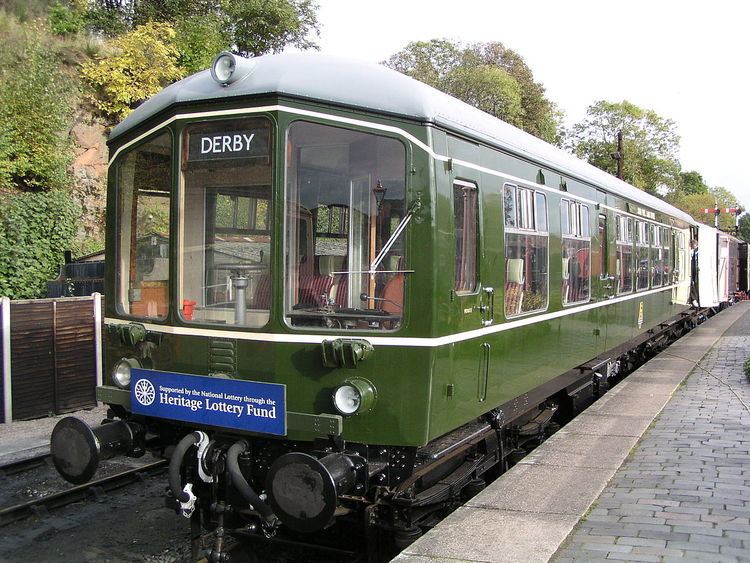In service 1954-1969 Number built 217 vehicles | Manufacturer BR Derby Works | |
 | ||
Formation 1, 2 & 4 Car Formations Capacity 16 1st + 53 3rd class (motor composite), 61 3rd class (motor third brake) | ||
The British Rail Derby Lightweight diesel multiple units, were the first such trains to be built en-masse for British Railways. The units were built at BR's Derby Works from 1954 to 1955. The units were built in various formations, including 12 power-twin 2-car units, 84 power-trailer 2-car units, and four 4-car units. The two single car units were originally built as a two-car unit and then split two years later when demand came about.
Contents
- Operations
- Formations
- Single Car Units
- Power Twins 7900079500 to 7900779507
- Remainder of the fleet
- Departmental Use
- Preservation
- References
Body framing was extruded and riveted together. Panelling was welded into continuous sheets and riveted to the frame. Luggage racks were light alloy. The floors had 2 layers of flameproof hardboard, covered with linoleum. To reduce noise and condensation, the inside structure and undersides were sprayed with asbestos. Lighting was by 60-watt, 24-volt lamps charged by belt driven dynamos. Heating was oil fired. Standard mild steel bogies ran on Timken roller bearings.
Contemporaneous with these units was the unique Battery Electric Multiple Unit.
Operations
The first units were introduced on services around the West Riding of Yorkshire, namely Leeds to Bradford and Harrogate services from 14 June 1954. Subsequent units were introduced onto services in West Cumbria, Lincolnshire, Norfolk, Newcastle to Middlesbrough, Edinburgh to Glasgow and, later, Birmingham to Sutton Coldfield, Bletchley to Buckingham and Banbury, and East London lines services. They were also the last units to run on the Anglesey Central Railway which closed to public traffic in 1964.
These units were an outstanding success, helping to reduce the operating costs of branchlines. Initially they also attracted many more passengers. Between February and October 1956 on the London Midland, they carried 800,000 more passengers than steam in the same period of 1955. The largest increase was 434% (4,772 passengers) on the Buckingham-Banbury line (from 13 August), followed by Birmingham-Lichfield 178% (from 5 March), Bury-Bacup 152% (from 6 February), Llandudno-Blaenau Ffestiniog 39% (from 5 March) and Manchester-Buxton 38% (from 8 October). As such, British Railways ordered many more DMU vehicles from various builders over the next decade, thus helping to eliminate steam locomotives. However, as these units were non-standard compared to other later DMU vehicles, they were subject to early retirement. The last units were withdrawn from normal traffic in 1969.
Formations
Four different sorts of formation were created from the 217 cars built of this type, as follows:
Single Car Units
79683 was left over as a spare DTCL, and took the place of 79649 in 1957, when this was converted into a special saloon on diagram 565. It was later renumbered 999510 in the departmental saloon series and was eventually scrapped in 1981.
In 1962 three of the power twin units were converted to power trailer units, when 79191–79193 were rebuilt as DTCL vehicles and renumbered 79633–79635.
Power Twins 79000+79500 to 79007+79507
Remainder of the fleet
Departmental Use
A number of cars from these units were subsequently transferred to departmental (non-revenue earning) use after withdrawal from normal service:
Preservation
Thanks to their extended life in departmental service, one 2-car unit and a single car unit survive in preservation, the former following a high-profile campaign.
